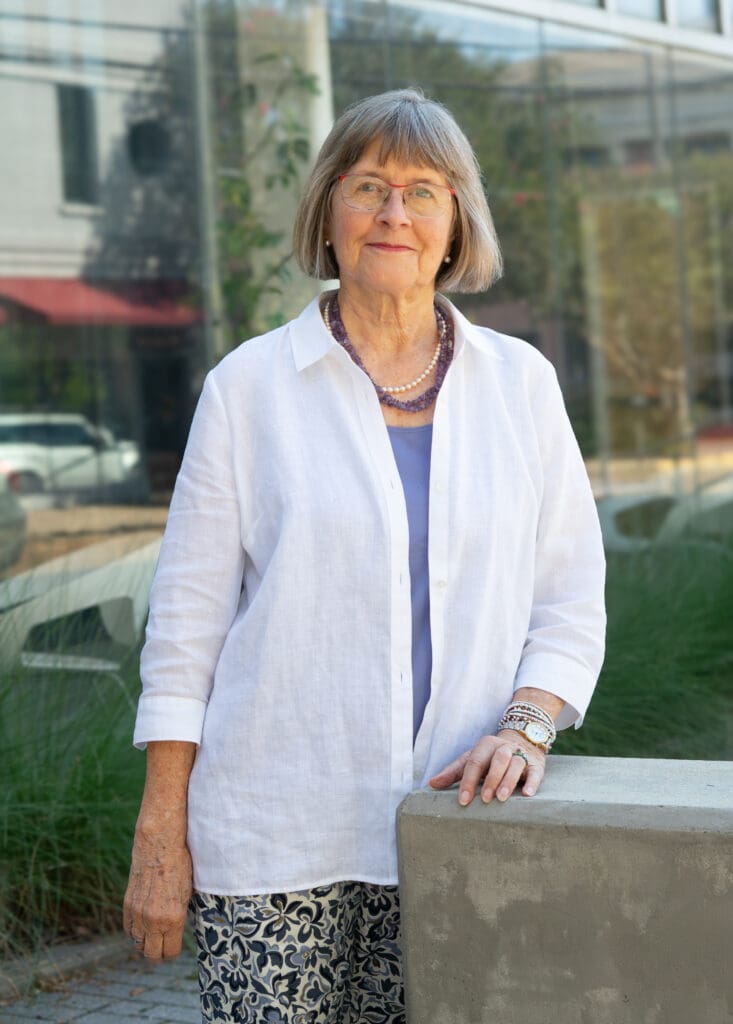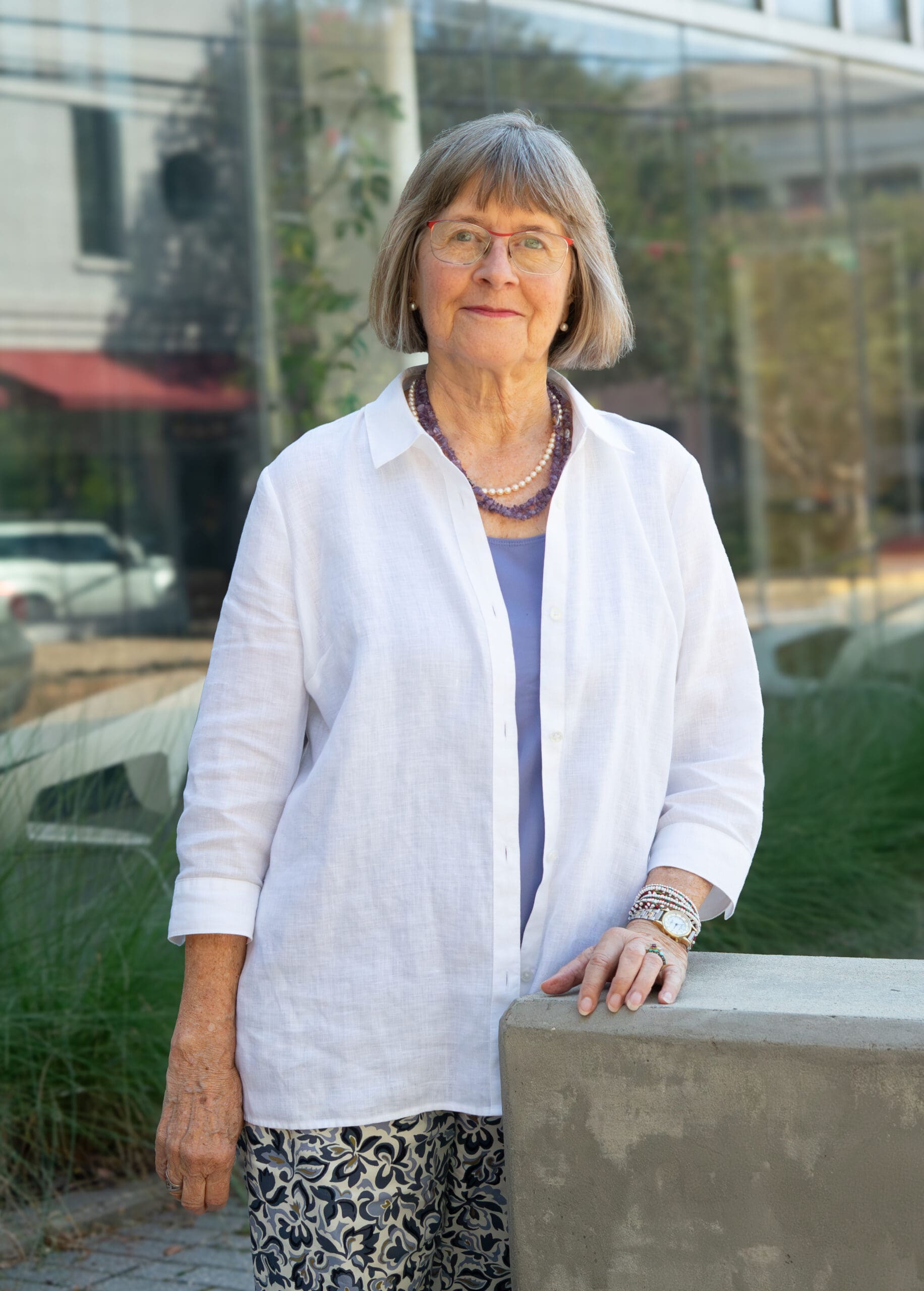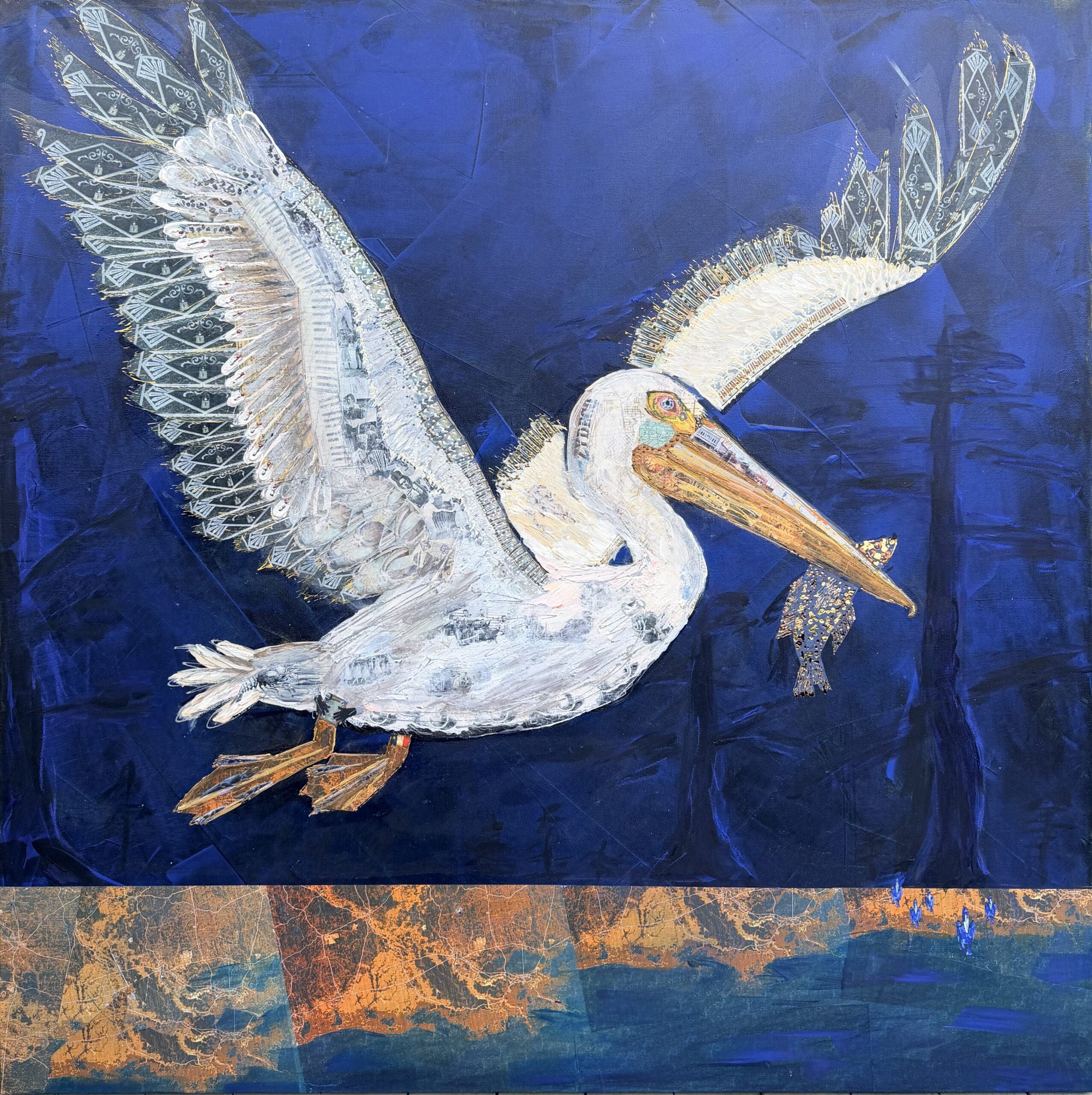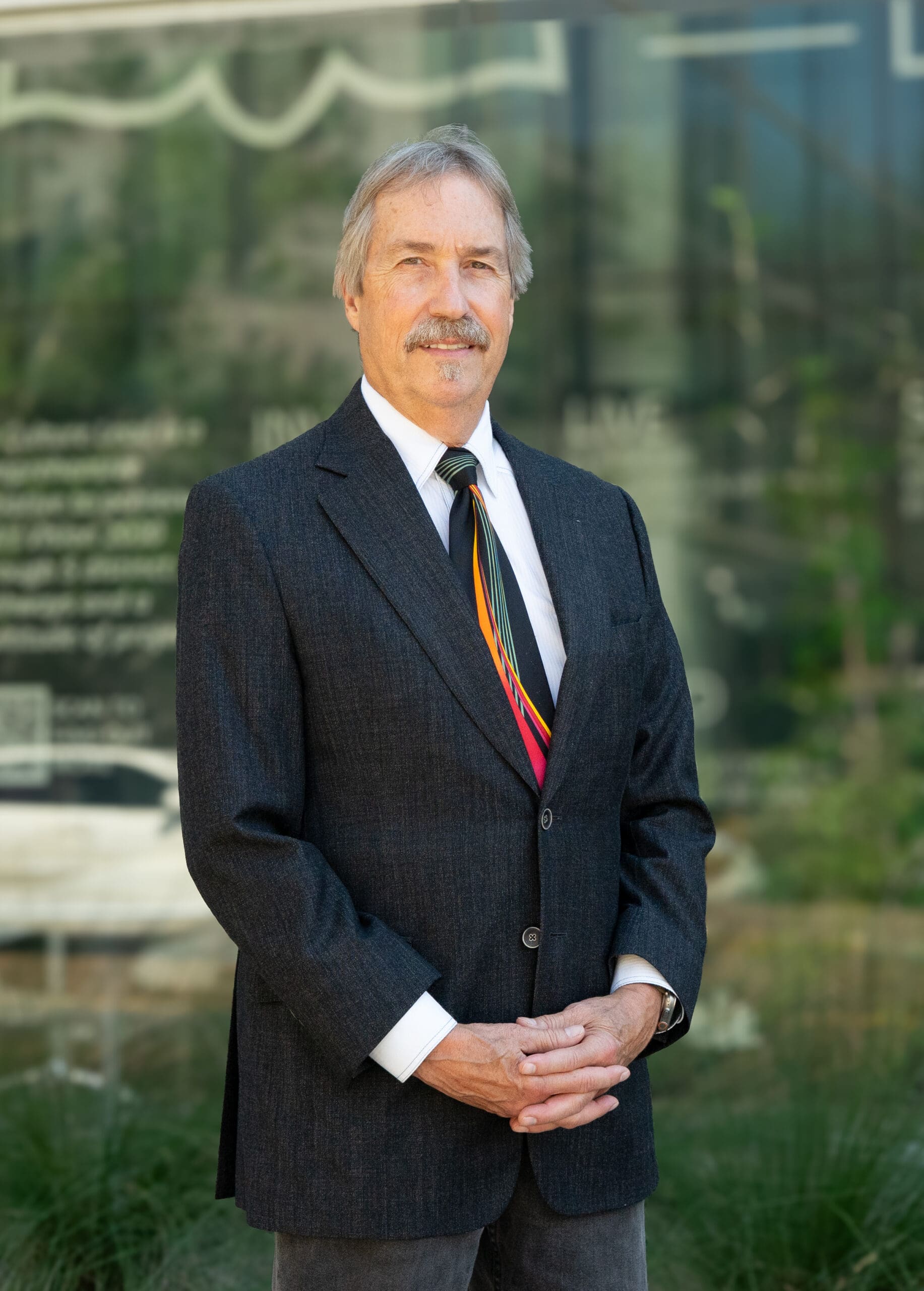
Meet Renée Roberts – 2025 Honorary Member Pelican Ball Honoree
Louisiana’s state flag depicts a mother pelican vulning, or piercing her own breast with her beak to sustain her nestlings with her own blood in a time where food is scarce. It’s an unvarnished representation of a mother’s love for her children, her self-sacrifice for the sake of nourishing her young. We need no convincing that the mother pelican’s act of sustaining life is pure instinct – we know there is no self-pity or second thoughts in her giving.
Anyone who’s known a good mother knows that she will look after all children, not just the ones borne of her own flesh.
Renée Roberts’ long and generative history with the Acadiana Center for the Arts is based on her own maternal instinct, paired with her deep conviction that art is for all children.
It begins with her as a young mother living in Lafayette, some time in the late 1970s. Roberts came across an article about how a Texas opera company had recently performed for students at one of Lafayette’s elementary schools. Immediately she was struck: How do I get this to happen for my kids, at their schools?
“Back then, not every school could afford to pay for this kind of art programming,” recalls Roberts. “I thought about my own childhood, and how important art was to me growing up. I went straight to the Arts Council.”
Before the AcA became what it is today it was the Acadiana Arts Council, which functioned as a sort of conduit to funnel federal and state grant funds to individuals and smaller organizations. Its patrons tended toward being moneyed, its programming presented in private homes or better-off schools. The Council was bringing great art to Acadiana, but its audiences were limited.
Roberts was recruited to volunteer for the Arts Council, handing out brochures at the Acadiana Mall on the south side of Lafayette. She was eager to help, to collaborate with this organization that already had a foothold in the game.
“I wondered how I could get people’s attention, how I could get them to stop while out shopping and listen to me about arts programming,” says Roberts. She knew she needed a way to lure them into her orbit, a way to get them interested in what she had to say about the weight of art in children’s lives.
“So I brought noodles.”
Roberts set up a table with brightly spray-painted pasta and string, offering a way for children to create and a venue for conversations with parents about why art should be part of their lives. The perennial pasta necklace brought the children to the table, and Roberts was able to spread the word about how the arts are essential for people of all ages and all economic backgrounds.
When she was a child herself, Roberts’ mother exposed her to art any which way she could.
“My dad was in the Navy, and as we moved around we’d go to dress rehearsals because they were free,” Roberts recalls, the story echoing her own frugal and imaginative ways of accessing art.
“Art was my connection to the ground, to the earth.
“My mom made the arts our roots – we were always in museums, libraries. That way, wherever we went, if we could have the arts in our lives, we were grounded. I wanted the same for my kids.”
When she looks back, Roberts sees hard work, and collaboration that brought us here today.
“I always tried to get as many people, as many organizations, involved as I could,” she says. “For me, it was always about how we could make people feel like they were a part of whatever was happening.”
She partnered early on with Festival International de Louisiane to develop Place des Enfants (now called Scène des Jeunes). She volunteered to create a kid-friendly makerspace where young attendees could express themselves in a way that connected to what was happening around them. Enough supplies were purchased for around 200 kids to create art, and thousands arrived by bus to take part. Roberts went out to buy more supplies to make it work.
Her make-do nature was noted by organizers, and she was soon hired by the Arts Council to help bring performing arts into Acadiana’s schools through their Touring Arts program, allowing for students to experience performances by artists who were otherwise performing for high-paying ticketed patrons. Small-town kids from families with limited resources were exposed to world-class performances by dancers, theatre troupes, musicians.
Roberts eventually was named Director of Arts in Education at the Council, and helped to expand the program that would bring Acadiana’s artists into classrooms – Bright New Worlds. Artists were paid fair wage to demonstrate their creative processes inside Lafayette’s classrooms, bringing in lessons about Kandinsky and collage and portraiture.
“These artists weren’t only bringing in art lessons – they were sharing their culture,” reflects Roberts. “We had brilliant people coming into schools and turning the kids onto the culture they all shared.”
Soon came Arts Grants for Teachers, which allowed the work to continue in the AcA’s absence.
“After teachers saw how these arts experiences activated the students, they wanted to find ways to continue it in their classrooms,” says Roberts. “So we came up with a way to give them money to pay for them to keep going.”
The PACE (Primary Academic and Creative Experiences) program followed, where artists and classroom teachers developed partnerships that brought lessons built around actual Louisiana learning standards, all across the curriculum. An influential – and still active – partnership with the Kennedy Center acted as a huge catalyst for the AcA to grow as an educating institution, cementing an alliance across the AcA, LPSS, and UL Lafayette (then USL).
Roberts’ early efforts paved the way for the AcA’s flourishing Arts in Education program to now exist in 135 schools across Acadiana, employing over 50 teaching artists.
Interestingly, the Pelican in AcA’s Pelican Ball wouldn’t exist without Renée Roberts. The idea for the painted pelicans you see smattered about Lafayette and installed in front of several Acadiana schools came from a trip Roberts took to Chicago, and to this day raises funds for AcA’s Arts in Education programming.
In the year 2000, Roberts took a trip to Chicago, discovered that artist-designed fiberglass cow statues were used to raise funds for nonprofits and charity organizations, and got the idea to do something similar with pelicans in Acadiana to raise money for their Arts in Education program. But how?
Roberts and some key players from LPSS decided the ten Title I elementary schools of Lafayette Parish would house the pelicans, and that it would be a great fundraiser for their Arts in Education program.
The pelicans would stand proudly in front of each school, a beacon indicating to people that: “This is a Title I school. They’re using art as a learning tool,” as Roberts puts it.
Children at each school collaborated with a teaching artist to design their school’s pelican. Roberts found a boatmaker to create fiberglass pelicans – young pelicans, specifically, to reflect the program’s young flocks. Eventually others wanted in, businesses and individuals alike, vying to get their hands on their own illustrated pelican.
“We put pelicans up for adoption,” recalls Roberts. “We had artists draw their ideas…we had this gallery showing of all these concepts, the walls covered with these decorated pelicans.”
The pelican project turned into something bigger than just a fundraiser.
“We had a field guide to all the pelicans,” says Roberts. “People would come into town to tour the birds! They’d pick up the field guide and map and go from bird to bird. They were so into it.”
A lot of the birds can still be spotted, including all ten standing proudly at each of the elementary schools.
AcA now holds the annual Pelican Ball, the first of which marked the 20-year anniversary of the project. The ball acts as a fundraiser, with a focus on arts education, and it’s the one time a year anyone (with the right donation) can get their own artist-designed pelican – one pelican is commissioned by the AcA and another “ghost pelican” is blank and can be commissioned by the auction winner to be designed by an artist of their choice.
Roberts’ pelicans still persist as symbols of her hard work, and her trust in collaboration with her community. She believed, and still believes, in bringing in as many people as she could to share the act of creating.
“You don’t just take – it’s about giving back. It’s about sharing.”
Roberts doesn’t boast about the hard work she’s done, but marvels aloud at the power of working together. She doesn’t claim credit for bringing the AcA to life, but her DNA is all over its journey to becoming what it is now. The momentum she set in motion still moves us, and she did it all with sheer force of will as her greatest resource.
Smiling, Roberts says that she still has boxes of spray-painted noodles stored in her garage. There is faith in those dusty boxes – the mother and the artist in her know there is still potential there. Maybe that’s why she never threw them out. There is humility in believing that a few cents’ worth of pasta holds the power to change a child’s arc of existence.
It takes humility to believe that working together is more powerful than working alone.
Roberts’ work has never been about recognition or accolades; it’s always been collaborative, grounded in community, and humble. Humble as a mother’s love.
Written by Brooke Broussard



